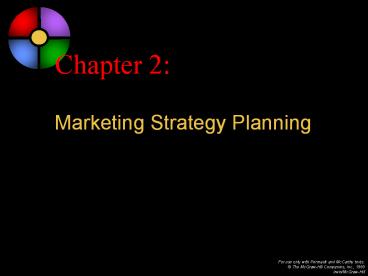Basic Marketing, 13th edition - PowerPoint PPT Presentation
Title:
Basic Marketing, 13th edition
Description:
Marketing Strategy Planning. For use only with ... Vaguely aims at 'everyone' with the same marketing mix ... Each plan is based on a marketing strategy ... – PowerPoint PPT presentation
Number of Views:865
Avg rating:3.0/5.0
Title: Basic Marketing, 13th edition
1
Chapter 2 Marketing Strategy Planning
2
The Marketing Management Process
Exhibit 2-4
2-9
3
Target Marketing vs. Mass Marketing
- TARGET MARKETING
- Marketing mix is tailored to fit specific target
customer(s) - MASS MARKETING
- Vaguely aims at "everyone" with the same
marketing mix
4
Marketing Strategy Planning
Exhibit 2-5
2-10
5
The Four Ps of the Marketing Mix
Exhibit 2-7
2-11
6
Strategy Decision Areas Organized by the Four Ps
Exhibit 2-8
2-12
7
The Marketing Plan
- Marketing plan a written statement of a
marketing strategy and the time related details
for carrying out the strategy. - Spells out, in detail
- What marketing mix is to be offered
- To what target market
- For how long
- What resources (costs) are needed at what rate
- What results are expected
- What control procedures will be used.
8
Marketing Program
- Marketing program blends all of the firm's
marketing plans into one "big" planwhich is an
integrated part of the whole-company strategic
plan - Program requires an effective "building up"
process - A good program must be based on good plans
- Each plan must be carefully developed
- Each plan is based on a marketing strategy
- Each strategy is based on a marketing mix and a
target market - Plans in overall program should work together to
enhance a competitive advantage
9
Marketing Objectives
- Should Be in Writing
- Objectives must be clearly defined
quantitatively measured - Measures should be taken at regular intervals
- Measures must be useful to managers
- Measures should be linked to rewards
- Measures should directly relate to tactical and
strategic goals of the firm
10
Profits, Revenues Costs
- Marketing Concept meet the needs of the target
market at a profit (C1, pg 16). - Profits Total Revenues Total Costs
- What are Revenues?
- What are Costs?
11
Revenues
- Total Revenues price x quantity sold
- Example Price 10 a unit. 50 Units sold
- Total Revenues 50 x 10 500
12
Revenues
- Most companies sell multiple products and
revenues are summed across products sold - Example Company sells Product A Product B
- Product A price 10 B 20
- Units Sold A 50 B 100
- What is the total revenue?
13
Total Revenue
- (10 x 50) (20 x 100)
- 2,500
14
Costs
- Total Costs Fixed Costs Variable Costs
- Fixed Costs Costs that do not change over some
time period or level of production - Variable Costs costs that change when units
produced or sold changes
15
Costs Example
- Movie Theater monthly rent 4,000
- Monthly Utilities 1,000
- Labor Costs 3,000 if avg. number of people go
to the movies - 2,000 if people going to the movies is 25
below average - 5,000 if people going to the movies is 50
greater than average - What are fixed costs? Variable Costs?
16
Movie Theater Costs
- Fixed Costs 5,000
- Variable Costs 2,000 3,000 or 5,000
depending on attendance
17
Customer Equity Differentiation
- Customer Equity is the expected earnings stream
(profitability) of a firms current and
prospective customers over some period of time
(pg 43). - Differentiation means that the marketing mix is
distinct from and better than what is available
from a competitor (pg 50)
18
Only 3 Ways A Firm Increase Profits
- 1 Sell more units at the same price (if selling
above costs) - 2 Lower costs while maintaining price and
quantity sold - 3 Meet target market needs better than
competitors and successfully charge a higher price
19
Companies that are highly profitable
- May have higher or lower costs per unit than
competitors - May sell more or fewer units than competitors
- May have a higher or lower price than competitors
- We judge marketing success by profits NOT
costs, units sold, price or total revenues ALONE
20
Competitive Advantage
- Competitive advantage the firm has a marketing
mix that the target market sees as better than a
competitor's mix - A better marketing mix offers target customers
better customer value - Note customers who are not in the target market
may not see the marketing mix as offering better
value - Requires that the firm
- understand current competitors' offerings
- anticipate competitors' likely plans
- monitor effects of changes in competition
- REALLY understand the target customers' needs
21
Marketing Strategy Planning Process
Exhibit 3-1
3-3
22
Types of Opportunities
Exhibit 3-2
3-4
23
Examples of Different Types of Opportunities
- Market Penetration
- Arm Hammer promotes new uses of its baking soda
- Market Development
- Marriott Hotels target families for weekend
"get-aways" to rent rooms filled by business
travelers during the week - Product Development
- Microsoft develops a new version of its Windows
operating system to appeal to the people who
bought an earlier version but now want more
features - Diversification
- RJR, the cigarette producer, adds baked goods to
its product line to appeal to new customers
24
Considering International Opportunities
Competitive Advantage
Smaller World
Better Trends?
Early Start
3-5































